How to choose enamel for bath restoration: a comparative review of popular products
Sooner or later everything falls into disrepair. This applies not only to things, but also to plumbing equipment.The bathtub, which just recently shone with whiteness, after some time will inevitably turn yellow, lose its gloss and become covered with a network of cracks.
Agree, a complete replacement of plumbing fixtures is a costly and troublesome undertaking. If the integrity of the bowl is preserved, you can extend its service life by repainting the surface of the bathtub. This service can be ordered from a specialized company or you can do the work yourself. The main thing is to choose a high-quality composition.
Before choosing enamel for bathtub restoration, you need to find out more information about the products available in plumbing stores. We have described in detail the pros and cons, as well as the specifics of applying different compositions.
To make it easier for you to make a choice, we suggest that you familiarize yourself with a review of popular enamels that have received a lot of positive feedback from consumers. Among them are products of domestic and foreign companies.
The content of the article:
What is bath enamel?
Each cast iron bathtub undergoes a complex enameling procedure during the manufacturing process. Actually, the enamel on its surface is a special glassy substance, which under special conditions is applied to the surface of the bowl. This happens in several stages using the spraying method.
Enamel powder is applied to the very heated inner surface of the bath. Under the influence of high temperature during the firing process, it is baked.
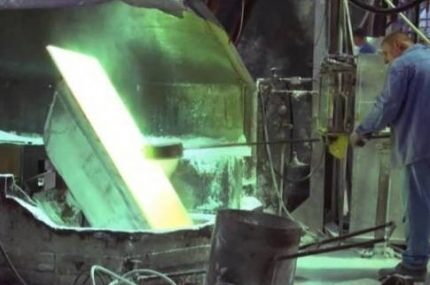
This procedure is repeated several times until a durable enamel coating of sufficient thickness is obtained. It is clear that it is impossible to repeat this procedure at home.
However, manufacturers offer products for so-called cold enameling. She assumes that the enamel will be applied without firing. The resulting coating can only be conditionally called enamel; it will have different performance characteristics.
Home Restoration: Pros and Cons
Before deciding to enamel a bathtub at home, its owners, as a rule, find a lot of positive and negative reviews from those who have already done it. Let's try to systematize them.
So, the advantages of self-enamelling include:
- Aesthetics. The ability to get an updated bath without dismantling old equipment and without carrying out related repair work.
- Availability. The cost of the restoration product is relatively low.
- Possibility of self-painting. If you wish, you can carry out the work on cold enameling a bathtub yourself, therefore saving on the services of specialists.
- Variability of colors. The enamel that is applied to the bowl can be of almost any color. It is obtained using a tinting agent, which is included with the enamel or purchased separately.
- Maintainability. The coating obtained during the cold enameling process can be restored.
Homemade enamel also has its disadvantages.
It should be noted that they are quite significant:
- Fragility. The service life of the applied coating is much shorter than that of factory enamel. It depends on the material with which the bath is covered. On average, such enamel will last for 5-8 years, after which you can apply a new layer of restoration product.
- Low stability to various mechanical damages. Even a not very heavy object falling into the bathtub from a small height can damage the coating.
- Chemical sensitivity. Bleaches, paints, photo reagents, etc. the compositions provoke a change in the shade of the enamel.
- Requirement for care. IN cleaning products There should be no abrasives or bleaches. Ideally, the bath should be washed with ordinary soapy water.
We have listed the main advantages and disadvantages of home enameling. What outweighs, everyone decides for himself.

The only thing I would like to pay special attention to is the correctness bathtub restoration. If all the requirements of the manufacturer of the product are not strictly met, the new coating will not exhibit the declared performance characteristics, will be fragile and will not last very long.
The process of applying an enamel coating to the inner surface of the bowl of everyone’s favorite plumbing fixtures includes several standard steps:
What you need to know about enamels
There are a lot of enamel restorers for baths. They differ not only in composition, but also in the method of application.
The enamel can be applied to the base with a brush or roller. In this case, the composition should be quite thick. It is best to use a hard brush to make it easier to rub the enamel over the base. It is advisable that the bristles do not come out of the brush; this will ruin the attractive appearance of the bowl.
Using a roller makes it easier to apply enamel. It distributes the composition as evenly as possible, but it is impossible to completely process the entire bowl with a roller. Where it bends you will need a brush.
Another method of applying enamel is spraying. Professionals most often use a spray gun in their work. A liquid composition is poured into it, which is applied in several layers. For non-professionals, this option is often unacceptable due to its complexity.
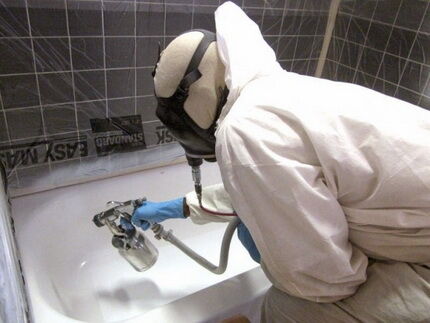
You can use an aerosol can with special enamel. When applied correctly, the result is a fairly durable and uniform coating. If the work is carried out incorrectly, the coloring may be uneven and spots of different shades will appear on the surface of the bowl.
Some experts believe that enamel in the form of an aerosol is best used to mask small defects, but not to restore the entire bathtub.
When purchasing a product, you should pay attention to its contents. It's best if it includes a bowl pre-treatment, perhaps even a special application tool.
It is advisable that the kit includes tinting compounds that allow you to obtain any desired shade. If you purchase two-component enamel, you should look at the color of the hardener.Dark colors are not recommended. They can impart an undesirable tint to the finished product.
Varieties of compositions for cold enameling
Bathtub restoration can be carried out with different compositions. Let's look at the main types of paints and varnishes used for these purposes.
Two-component epoxy enamel
It is a suspension containing epoxy resin, fillers and pigments. The peculiarity of the material is that it has a two-component composition, so before application, a hardener is added to the solution and mixed well.
The ready-to-use composition should be used for a limited amount of time; it hardens fairly quickly.
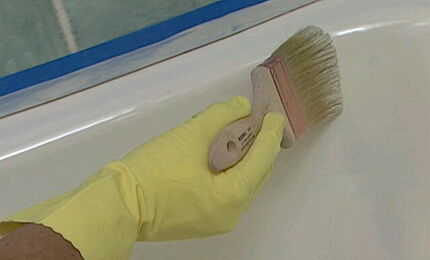
The advantages of epoxy enamel include:
- after the composition hardens, a uniform, glossy, very smooth coating is obtained;
- good adhesion to cast iron and other metals;
- high wear resistance and strength - a properly applied coating can be cleaned with abrasive agents and will last about 15 years;
- epoxy enamel is insensitive to alkalis and acids;
- the cost of the material is relatively low.
This enamel also has significant disadvantages. First of all, it is toxic and has a strong unpleasant odor. When working with the composition, you must wear a respirator and protective rubber gloves. The material is prone to sagging, so you should strictly follow the manufacturer's recommendations regarding the consistency of the solution.
Given the high rate of hardening of epoxy enamel, you need to work with it quickly.This can be inconvenient for those trying to refinish an old bathtub for the first time. Another disadvantage is that over time the coating may turn yellow, this is especially true for compositions with a dark-colored hardener.
Aerosol products
Different enamels can be produced in aerosol form: epoxy, acrylic, one- and two-component. This must be taken into account when purchasing. The composition in the can is completely ready for application; you just need to shake it well.
Advantages of using aerosols:
- simple and quick application of the composition - no tools are required;
- aerosol enamel adheres well, the coating is smooth and shiny;
- special additives in the compositions make it possible to imitate different textures and obtain a pearlescent or fluorescent surface;
- Enamels of this type require several hours to completely cure.
The disadvantages include the small thickness of the applied layer. The composition in the can is very liquid, which is due to the peculiarities of its application. It contains a large amount of solvent.
Therefore, the enamel lies on the surface in a very thin layer, which wears off quite quickly. For the same reason, the base must be carefully prepared.

Spray enamel will not cover small defects in the bowl, such as chips or cracks. Mixing compositions from different cans to obtain a new shade is not allowed. If the manufacturer's requirements were not followed when applying the enamel, it will lie unevenly. Streaks or streaks may appear.
Latex or acrylic enamel
Also known as liquid or self-leveling acrylic. The material is an acrylic two-component enamel, so it needs to be thoroughly mixed before use. As a result of using the composition, a glossy, uniform coating is obtained.
The advantages of liquid acrylic are:
- high resistance to abrasion, as well as various mechanical damage;
- the coefficient of thermal conductivity is low, which makes it possible to retain heat well;
- Over time, the coating does not lose its whiteness;
- a bowl coated with acrylic becomes non-slip and therefore safe to use;
- good adhesion to substrates made of various materials: cast iron, steel, acrylic;
- ease of care.
The coating also has disadvantages. The material has a pungent odor, so you can only work with it in a respirator. Acrylic enamels do not adhere well to a plastic base. To improve adhesion, you will have to carry out additional preparatory work and be sure to prime the base.
The bowl is prepared in any case. If it is done poorly, the coating will begin to peel off over time.
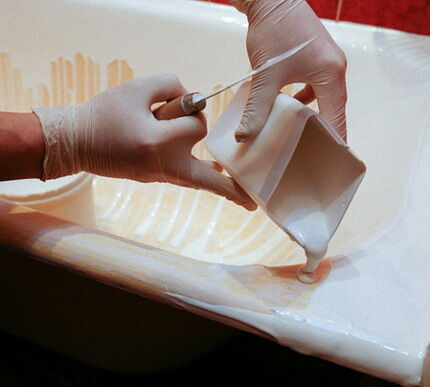
Liquid acrylic is applied to the bowl using the pouring method. This means that the thick composition is carefully poured onto the side, from where it flows into the bowl on its own, forming a new coating.
This way applying liquid acrylic requires a large amount of material, so its consumption is much higher than when applied with a roller or brush. Accordingly, the financial costs of purchasing enamel are quite significant.
In order to cover a bathtub with liquid acrylic, you need to perform a number of traditional steps:
Review of popular enamels for bath restoration
The range of materials for bowl restoration is large, so it is very difficult to say which bath enamel is considered the best. For each bath, the composition should be selected individually, taking into account the characteristics of a particular product. Practice shows that such compositions are most in demand by consumers.
Reflex 50 from the famous brand Tikkurila
A two-component epoxy material designed for the restoration of enamel bathtubs. Can be used for concrete pools. Available in white, high gloss. The manufacturer warns that the composition may turn yellow over time. Only solvent is used to dilute the composition Novopox.
Enamel can be applied to the base using different methods: by roller or brush, as well as by spraying under low or high pressure. For each type of application, a certain thickness of the material is selected. Before work you need to prepare the composition.
To do this, mix four parts of enamel and one part of hardener. The solution can be used for four hours after mixing.
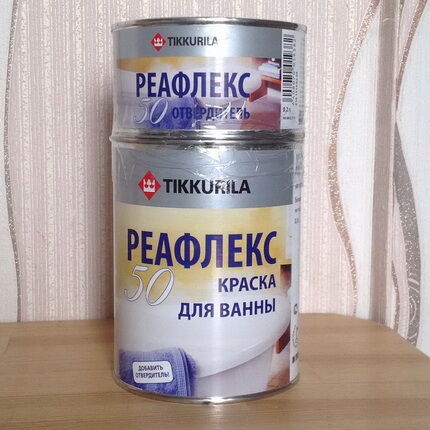
The composition takes quite a long time to dry. Drying “from dust” occurs within one hour, and complete hardening of the layer takes from eight hours to two days. After this time, each subsequent layer is applied. After restoration, the bathtub will be ready for full use only after seven days.
Before starting work, the old enamel surface is cleaned, sanded to a matte state, washed and degreased.Next, priming must be carried out with enamel diluted by 20%. Reflex.
After this, if necessary, base defects are repaired. Eight hours after priming, you can begin applying enamel. It is laid in at least two layers.
Epoksin 51 and its variety Epoksin 51C
Two-component enamels made on the basis of epoxy resin. A colorless transparent amine-type hardener is used as the second component, which protects the finished coating from yellowing.
As a result of application Epoxy A glossy, uniform coating is formed. The working composition is quite thick, so it can mask minor defects in the base.
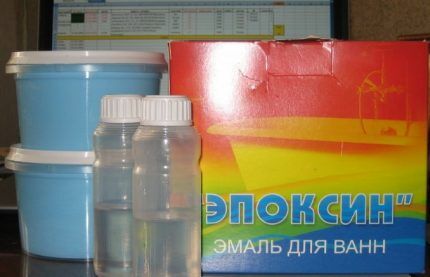
The solution is mixed immediately before application. The exact proportions for mixing are indicated on the packaging of the material. The composition can be diluted with solvents R-12, 647 and 646. To apply the enamel, you can use a brush or roller.
After adding the hardener, the composition must be used for 50-60 minutes, after which it is unsuitable for use. The manufacturer recommends diluting the enamel separately for each applied layer.
Before starting work on applying enamel, the bowl must be thoroughly cleaned until the glossy sheen is completely removed. Then sand all defective areas present on it to a metallic shine. It is recommended to putty the largest of them.
The surface of the restored bath is freed from dust and washed. After this, in order to warm up, hot water is drawn into the bowl for five minutes. This is necessary for the bath to dry quickly.
After the hot water has been drained, the bowl is wiped and dried. The first layer of product is applied to the surface prepared in this way with a flat brush. The composition is thick, which makes it difficult to apply, as drips easily appear. They need to be rubbed straight away with a brush.
After the first layer has dried, which takes about an hour, the second layer is applied. Complete hardening of the enamel occurs within a day.
Aerosol KU-130 from KUDO
The enamel is made on the basis of modified artificial resins. Designed for restoration of enamel and ceramic coatings. The enamel coating is distinguished by high strength, good adhesion to various substrates, resistance to detergents and a long service life.
The enamel is completely ready for use; before applying it, the container is thoroughly shaken.
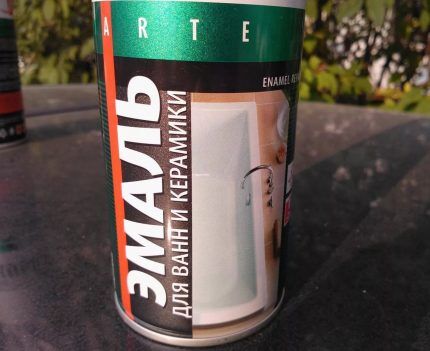
The manufacturer does not recommend working with the composition at ambient temperatures below +10°C. The surface of the bowl must be well cleaned and sanded before applying enamel. All base defects must be puttied.
The composition is liquid, so it does not cover even small flaws on the surface. The base must be degreased. For this it is recommended to use a solution "Silicone remover" the same brand.
The enamel is applied to the prepared base in two or three layers from a distance of 0.25-0.3 m. After applying each layer, it is allowed to dry for 20-25 minutes, after which the next one is applied.
The enamel dries completely within a day.You can use a bathroom restored with this composition three days after applying the composition.
Liquid acrylic from the EcoVanna company
The manufacturer produces several formulations that differ in additional additives. The line includes an antimicrobial, quick-drying and bactericidal coating. All materials are two-component enamels and require mixing before application to the bowl.
Liquid acrylic from EcoBaths has a slight odor, non-toxic and completely environmentally friendly.
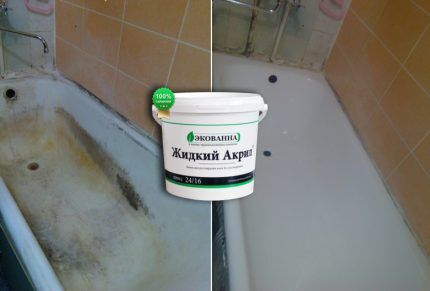
To apply the composition, the pouring method is used, and this requires certain skills. The consistency of the enamel is such that it is applied without bubbles or streaks. There are no impurities in the solution.
Properly applied coating will last up to 15 years. You can work with the composition only at temperatures from +21°C to +26°C, the temperature should be from +23°C to +25°C.
Before applying the enamel, the bathtub is thoroughly cleaned, washed to remove dust and dirt, and then degreased with acetone. The bowl is dried, and you can start applying the composition. It is poured in a circle along the sides of the bath and, if necessary, distributed with a soft rubber spatula.
After applying the enamel to the bowl, it should dry for 24 hours, after which you can install drain and overflow.
Some enamels advertised as suitable for bathtub restoration actually are not. These include alkyd compounds. Theoretically, they can be applied to metal, but the surface must be especially carefully prepared and primed.
In addition, alkyd paints are prone to the formation of drips, which are quite difficult to deal with. This composition must be applied in at least three to four layers. In this case, the service life of the coating will be only 5-6 years.
Conclusions and useful video on the topic
Watching the video is a great opportunity to see the practical application of enameling old bathtubs and learn basic skills.
How to properly restore a bathtub using enamel and a brush:
We restore the bathtub using an aerosol:
What is the pouring method - all the details of the procedure:
Finally, I would like to once again advise you to very carefully choose a bath restoration product. The abundance of such compounds can be misleading. It is important that the material is of high quality.
There is a certain guarantee when purchasing enamel from a popular brand.Otherwise, all the labor-intensive work on preparing the bowl and applying the composition will not give the expected result and you will have to do everything again or, which you really don’t want, change the bathtub to a new one.
Do you have experience restoring an old bathtub and using enamel? Please tell our readers what product you used, share your observations regarding the quality and ease of application of the composition. Leave comments and participate in discussions - the feedback form is located below.




You opened my eyes. I have long wanted to change the enamel in my bathtub. I thought that if you “painted” it, the enamel would last about 20 years. I don’t want to throw away a good cast-iron bowl. I also heard about such a method as an acrylic liner “bath in a bath.” Good or not? For something affordable and easy to do, almost everyone enjoys spray painting their bathtub. I'll most likely use this method. Simple and inexpensive.
Hello. Aerosol painting is one of the most complex and subtle application methods. About acrylic liners Here.
Isn't it better to cover the bathtub with acrylic? As for me, it is much more practical than enamel and more beautiful. Although the application process is more complicated. Is there such an article on the site?
Here, everyone decides at their own discretion what is the best way to cover a cast-iron bathtub during restoration. Enamel is easier to apply; with acrylic there are many nuances that need to be taken into account. As for the articles on the site on this topic, there are more than one. In my opinion this article describes the process best, especially the attached videos.
But when restoring a cast-iron bathtub, it is necessary to take into account that over the years, any applied coating will still turn yellow, be it acrylic or enamel - there is no difference. So once every 5-6 years you will have to repaint it or fill it with new acrylic. There is nothing you can do about it, these are the features of cast iron vans.